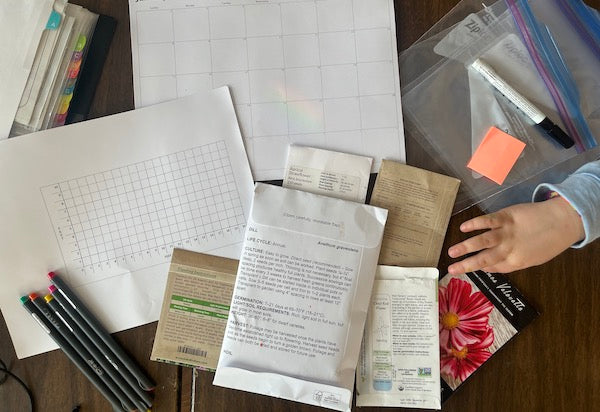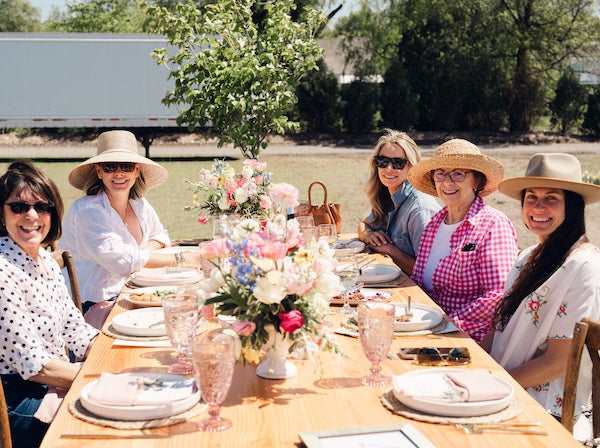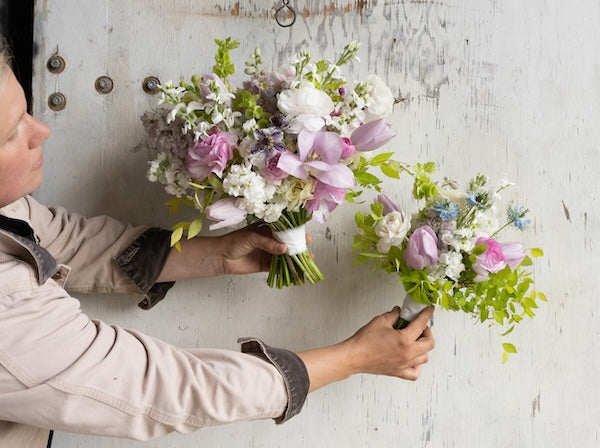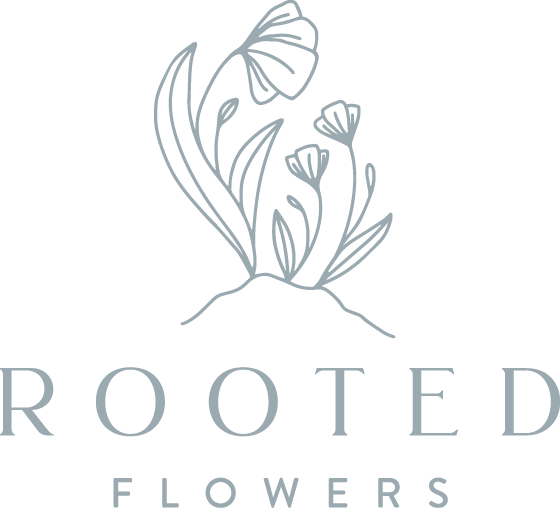- Book An Event
- FLOWERS & GIFTS
- GARDEN SHOP
- EXPERIENCES
- BLOG
- ABOUT
- Log in
How To Plan For Seed Starting Indoors
February 02, 2023 4 Comments

Starting seeds indoors is a fun and exciting way to bring the garden to life! Whether you are a seasoned gardener or a newcomer to the world of indoor seed starting, there are a few key things to consider to ensure success. With the right planning, you'll be well on your way to growing healthy, strong seedlings that will be ready to transplant into the garden in no time.

In this blog post, we will cover the important details to review on a seed packet, how to determine when to start seeds, how many seeds to start, pot or tray sizes, and how to make a schedule. So, grab your notebook and let's get started together!

The first step in planning your seed starting journey is to write down what you want to grow. Shoot for the moon and the rest of the process will weed out an overzealous list.
For example, if you are new to growing a flower garden, we recommend starting with a manageable 3-5 flower types. The more you grow, the more complicated it can feel. It’s not worth overwhelming yourself and getting defeated. Get a feel for growing before expanding.
Listed are flower types that can all be started at the same time and will yield simple, but beautiful mixed summer bouquets:
Zinnia, Marigold, Cosmo, Dill
Zinnia, Tithonia (Mexican Sunflower), Cosmos
Sunflower, Zinnia, Cosmo, Marigold, Celosia
Zinnia, Dill, Celosia, Cosmo
After a season or two, consider adding in an earlier round of seeds to start like snapdragon, strawflower, statice, or gomphrena.


Reviewing the seed packet or online growing information is an important step because it contains vital information about the seed, including the planting time, growing conditions, and spacing requirements. Here are the key details to look for:
- Recommended planting time: When to start your seeds based on the species and your last frost free date.
- Spacing requirements: The spacing between seeds and between rows, which will help you determine the number of seeds you need to start or how much space you need.
- Germination time: The average time it takes for the seeds to germinate or sprout, which will help you determine the ideal time to start seeds.
- Light requirements: The light conditions for the seeds to germinate and grow, which will help you determine how you start them. Some seeds require darkness.
- Soil temperature: The soil temperature will help you determine the ideal time and place to start seeds.

The next step is to determine when to start seeds. This is an important step because starting seeds at the wrong time can lead to plants that are not ready for planting outside or are ready too early in which they outgrow their pots and suffer leading to a poor quality plant.
- Check hardiness zone: This isn't critical knowledge for annual cut flower grower but very important to know as a gardener planting perennials (plants that come back every year). Nonetheless, it will help you determine which seeds are suitable for your area. CHECK YOUR HARDINESS ZONE
- Check local frost dates: You need to know! This is an anchor point in your schedule. If you plant too early, all your hard work could get hit by the cold and die. CHECK YOUR LAST FROST DATE
- Calculate the seed starting time: To determine when to start seeds, subtract the number of weeks of when to sow before last frost and germination time. This will give you the ideal start date for your seeds. If the seed packet gives you a window, we always opt for more weeks. It's easier to slow plant growth down than try to speed it up.
Here are examples of how many weeks we count back to start certain seeds:
6 weeks: zinnia, sunflower, marigold, cosmo
10 weeks: snapdragon, strawflower, statice, gomphrena
12 week: foxglove, eucalyptus, lisianthus, rudbeckia, dianthus

Once you have determined the ideal time to start seeds, the next step is to determine how many seeds to start. This is an important step because starting too many seeds can lead to overcrowding, while starting too few seeds can leave holes in your garden. It's time to draft your garden design!
1. Determine your garden size as seen in the graph above. The example includes a raised garden bed that is 4 feet by 12 feet.
2. Review the growing information for spacing between seeds and growth height. Knowing the height will determine where you place the flowers in your garden. Taller plants display better in the middle as a focal or in the background, while shorter plants are visible in the front or near a border. Note: On the chart, "T" is listed for tallest plants at the top and the flower list descends to "S" for shorter. A spacing of 12 inches was used in between each plant.
3. Determine the number of plants you need based on the size of the space you have in your garden. The design calls for 46 total plants. Once the design in complete, count back how many of each type are needed.
4. Calculate the number of seeds to start: Based on the ideal spacing and the number of seedlings you need, calculate the number of seeds to start. You will also want to consider the germination rate of the seeds, which can be found on the seed packet. It's a good idea to start extra seeds to account for any failures. A general rule of thumb is that 20% of the seeds planted won’t make it to the garden, so account for the loss. If you want 10 plants, start 12 seeds or multiply your desired amount by 1.2. 10 seeds x 1.2 = 12 total seeds. It's always better to plant more than you need!

The size of the containers you use for seed starting is important because it affects the health and growth of the seedlings, will determine how much space you need, and reusability. Here are a few factors to consider when selecting pot sizes:
- Drainage: Make sure the pots or trays have adequate drainage holes to prevent the soil from becoming waterlogged, which can lead to root rot. We always use a solid tray for bottom watering and place pots/trays into that. Set yourself up for longterm success with a universal system using 1020 trays. See our checklist at the end of this blog for recommended sources/sizes.
- Reusability: If you are trying to reduce waste, consider using reusable pots with common sizes to keep your system universal. See the Plannnig Guide at the end for detailed recommendations.
- Seed starting space: Knowing the demand of your seed space will let you know if you’ll be able to provide enough light & heat which is critical for their development. If you do not have a sunroom, greenhouse, or enough window space, consider our bulletproof Seed Starting System.
- If you have limited space or are working with really small seeds (like snapdragons), consider starting in channel trays, then transplanting to 4 or 6 packs. The packs provide the perfect root ball size and can hold up to 48 plants on one tray. Knowing what your plant goal is for your garden design will help determine the container sizing as well. Download the Planning Guide at the end of this post for a deeper look at sizing and sourcing.

Finally, it's important to make a schedule for your seed starting journey. This will help you keep track of the different flower types start dates and allow you to make improvements the following year. Use the charts made earlier to plug in your frost free date, then count back the weeks to plug in your groups of flowers to start.
Set an alert on your phone so that you don't miss it! Smart phones can even set a yearly alert so that you can 'set it and forget it."
Document your start dates and make future adjustments as needed to the schedule. Light and heat variations can either speed up or slow down growing conditions. You'll need to refine what works best for your conditions.

In a nut, proper planning before starting seeds is key to your seed starting success. Plan now to “set it and forget it” later. By reviewing the seed packets, determining when to start seeds, calculating how many seeds to start, selecting the right container sizes, and making a schedule, you will set yourself up for a successful and enjoyable seed starting experience.
You want to be observing growth and monitoring when to water - not fiddling with start dates. Monitor the growth is where all the good stuff happens and will help you to develop your green thumb quickly.
Happy gardening!
Below is an easy to follow, thoughtful resource to help guide you through the planning process.
4 Responses
Terri Kutayli
January 26, 2024
So excited to get my seeds organized and ready to go!!!
💐🌹🌻🌼
Jeanne
January 26, 2024
Thanks for your thorough plan and for the other resources too.
Deb lauzier
April 06, 2023
So excited to get my hands in the dirt and grow all I can !🌸🌺🌼🌻
If your comment doesn’t show up right away, don't fret! We have a spam filter that requires we approve most comments before they are published.
Unable to post at this time.
Also in Farm Journal

Rooted Flowers Holiday Gift Guide 2025
December 11, 2025
As another season comes to a close here at the farm, I’ve been reflecting on how much Rooted Flowers has grown and evolved. Each year feels like a whirlwind of planting, tending, harvesting, and planning for what comes next. With so much happening behind the scenes, I wanted to take a moment to gather everything we’re offering this holiday season in one place.

Bloom & Brunch: A Mother’s Day to Remember
May 29, 2025
This past Motherʼs Day, we opened the gates to Rooted Flowers for our very first Bloom & Brunch, and what unfolded felt like something out of a dream. After weeks of gray skies and unpredictable spring weather, the sun showed up right on cue—and so did all of you.

A Pastel Spring Wedding at Valley View Farm
May 27, 2025
This past weekend, we had the pleasure of designing wedding florals for a stunning celebration at Valley View Farm in Haydenville, MA. From seed to centerpiece, every flower was grown right here on our farm in Agawam, MA—a full farm-to-table floral experience for a couple who wanted something meaningful, local, and naturally beautiful.
Quick Links
Follow Us
We a family-run speciality cut flower farm growing in the Pioneer Valley of Western Massachusetts.
Our self-serve farmstand is located at 501 Shoemaker Ln, Agawam, MA 01001. We are open everyday with a fresh restock at 10 am.
Find us on Google Maps or Apple Maps
News & Updates
Sign Up For Our Newsletter
© 2026 Rooted Flowers. © COPYRIGHT ROOTED FLOWERS LLC 2024


Sally Back
April 22, 2025
Wonderful information! After 50 years of gardening with store bought plants I have been starting my own from seeds the past few years. One of the benefits is the variety you have with seeds. The other is the joy from seeing seeds grow to beautiful plants. I love it!